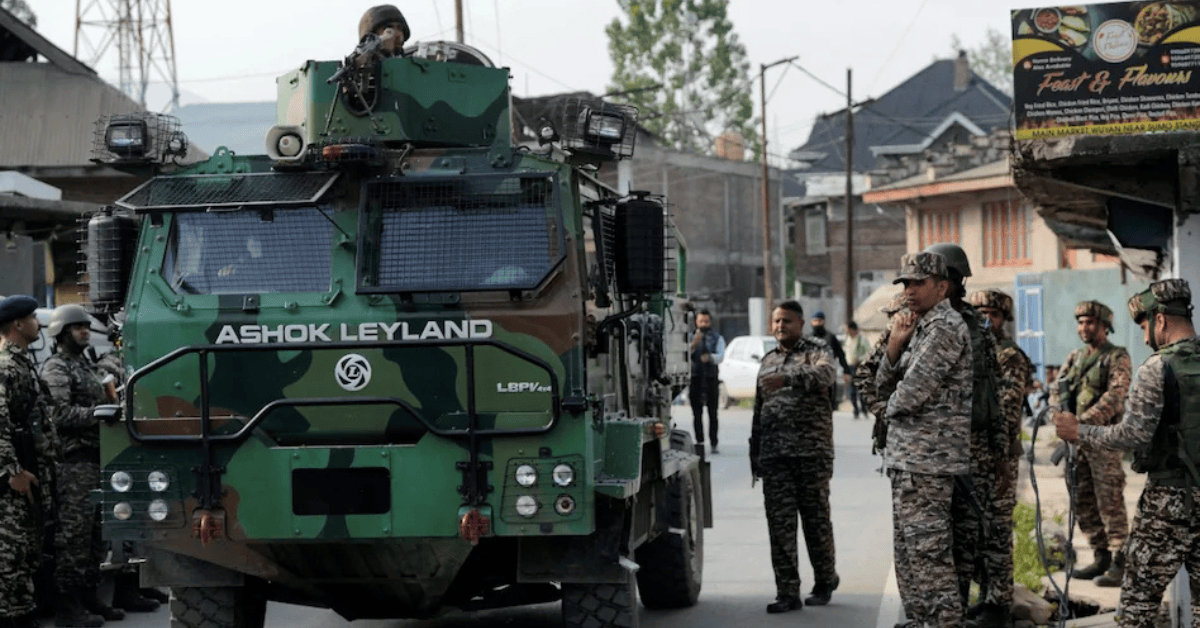On April 22, 2025, a serene tourist spot in Pahalgam, Jammu & Kashmir, turned into a scene of tragedy. A brutal terrorist attack claimed the lives of 26 civilians, including a Nepali national. The perpetrators? The Resistance Front (TRF), a Lashkar-e-Taiba offshoot. This heinous act wasn’t just an attack on innocent lives—it was a direct challenge to India’s sovereignty and security.
In response, India launched Operation Sindoor, a meticulously planned military operation aimed at dismantling terror infrastructures across the border. This article delves deep into the operation’s key facts, strategies, and implications.
What Exactly Was Operation Sindoor?
Operation Sindoor was India’s calculated military response to the Pahalgam terror attack. Unlike previous operations, this mission showcased India’s evolved strategy in counter-terrorism. Within a swift 23-minute window, Indian forces executed precision strikes on multiple terrorist facilities deep within Pakistani territory, all without crossing the Line of Control or international borders.
The operation’s name, “Sindoor,” symbolizes the red mark of valor and sacrifice, reflecting the nation’s resolve to protect its citizens and uphold justice.
Timeline: From Pahalgam Attack to Operation Sindoor
April 22, 2025: The Pahalgam attack occurs, killing 26 tourists.
April 23–May 6, 2025: India gathers intelligence, identifies targets, and prepares for a strategic response.
May 7, 2025: Operation Sindoor is launched at 1:28 AM, targeting nine terrorist camps.
May 8–10, 2025: Pakistan retaliates with drone and missile attacks, which are intercepted by India’s defense systems.
May 10, 2025: A ceasefire is brokered by the United States, leading to a fragile calm along the India-Pakistan border.
Key Facts About Operation Sindoor
Precision Strikes: The operation lasted 23 minutes, utilizing indigenous Akash missiles and suicide drones to target terrorist infrastructure without crossing the Line of Control.
Technological Prowess: Missiles tested at the Integrated Test Range in Chandipur, including BrahMos and Akash systems, were deployed with high accuracy.
Intelligence Support: Real-time intelligence and surveillance were provided by ISRO satellites, enhancing the operation’s effectiveness.
Casualties: India reported the elimination of over 100 terrorists, while Pakistan acknowledged 51 deaths, including 11 military personnel.
Infrastructure Damage: Approximately 20% of Pakistan’s air force assets were destroyed, including key airbases and fighter jets.
Leadership: Air Marshal Awadesh Kumar Bharti from Bihar played a pivotal role in the operation’s success.
Public Support: Railway stations across India were illuminated to honor the armed forces, reflecting nationwide support.
International Reactions: Global responses varied, with some countries supporting India’s right to self-defense and others calling for restraint.
Economic Impact: Udaipur halted ₹3,000 crore worth of marble imports from Turkey in protest against its support for Pakistan during the conflict.

Who Were the Key Figures Behind the Operation?
Several individuals played instrumental roles in the planning and execution of Operation Sindoor:
Air Marshal Awadesh Kumar Bharti: Hailing from Bihar’s Purnia district, Bharti’s leadership was pivotal. His disciplined upbringing and commitment to national service underscored the operation’s success.
Rajesh Kumar Singh: Serving as Defence Secretary, Singh oversaw the meticulous preparations, ensuring every detail was accounted for.
Their combined efforts, along with countless unnamed heroes, exemplify the dedication and professionalism of India’s defense forces.
What Were the Immediate Outcomes?
The operation achieved significant results:
Neutralization of Threats: Over 100 militants were eliminated, including key figures linked to previous terror activities.
Destruction of Infrastructure: Nine major terror sites, including those in Bahawalpur and Muridke, were decimated, crippling the operational capabilities of groups like Lashkar-e-Taiba and Jaish-e-Mohammed.
Minimal Collateral Damage: Thanks to precise targeting, civilian casualties were minimized, showcasing India’s commitment to ethical warfare.
How Did Pakistan and the International Community React?
Pakistan’s response was a mix of denial and retaliation. While they downplayed the damage, there were reports of counter-attacks, including drone and missile strikes, which were effectively intercepted by Indian defenses.
Internationally, reactions varied:
Support: Countries like the USA and France acknowledged India’s right to self-defense and praised the operation’s precision.
Criticism: Nations like Turkey and Azerbaijan condemned the strikes, leading to diplomatic tensions and trade repercussions.
What Were the Domestic Repercussions?
Operation Sindoor had a profound impact within India:
Public Sentiment: The nation rallied in support, with citizens expressing pride and solidarity.
Economic Decisions: In response to Turkey’s criticism, Udaipur halted ₹3,000 crore worth of marble imports from Turkey, reflecting a broader sentiment of economic nationalism.
Cultural Tributes: Railway stations across the country were illuminated in honor of the armed forces, symbolizing national unity and gratitude.
What Are the Future Implications?
Operation Sindoor signifies a paradigm shift in India’s approach to counter-terrorism:
Strategic Clarity: India has demonstrated its willingness to take decisive action against threats, setting a clear precedent.
Technological Advancement: The successful deployment of indigenous technology underscores India’s growing self-reliance in defense capabilities.
Diplomatic Posturing: By balancing military action with diplomatic restraint, India has positioned itself as a responsible global player committed to peace and security.
How Did India Maintain Secrecy Before Launching Operation Sindoor?
One of the most remarkable aspects of Operation Sindoor was how stealthily it was planned and executed. In an age where drone footage leaks faster than celebrity wedding photos, it’s honestly baffling how a full-blown military strike involving ISRO satellites, multiple battalions, and missile units remained under wraps. Intelligence sources revealed that most of the planning happened under “strategic blackouts,” a fancy way of saying “we unplugged everything and told no one.”
Only key personnel in the Indian Armed Forces, the National Security Advisor, and top brass in the Ministry of Defence were looped in. Not even cabinet ministers outside the core defense group were briefed. While some movements near the LoC were noticed by satellite watchers abroad, nothing was substantial enough to raise flags.
Even the final “go-ahead” came just hours before launch—straight from the Prime Minister’s Office—making it near impossible for the opposition, media, or even foreign intelligence agencies to sniff out what was about to go down. The level of coordination, speed, and discipline showcased India’s increasing maturity in handling asymmetric threats.

Is This India’s New Military Doctrine—Precision Retaliation Without Escalation?
We’ve seen India retaliate before—Kargil, Uri, Balakot. But Operation Sindoor feels different. It’s almost like India just upgraded from 3G to 6G in its military doctrine. No boots crossed the border, no grand press conferences—just precise, surgical, no-drama destruction. By hitting terrorist camps with zero collateral damage to civilians and avoiding Pakistani military establishments (except when retaliated upon), India sent a crystal-clear message: “We won’t play your game—we’ll rewrite the rules.”
Some defense analysts are calling it “smart power”—India choosing impact over spectacle. And let’s be honest, it’s a lot harder for Pakistan to play the victim card when India didn’t even cross the LoC. This kind of response strategy—tech-assisted, high-intel, fast-execution missions—could become the template for future counter-terror ops.
Think: more drones, better AI for target recognition, and even satellite-aided real-time decision-making. It also helps India maintain diplomatic goodwill with global powers while addressing domestic calls for justice. Balanced aggression might just be the new playbook.
Could Operation Sindoor Spark a New Arms Race or Redefine India’s Global Standing?
Let’s talk big picture. Operation Sindoor didn’t just affect India and Pakistan—it made the whole neighborhood look up from their tea cups. China took notes. The U.S. issued a carefully-worded statement. And Russia? Let’s just say their silence was strategic. India’s successful execution of such a high-risk operation without dragging the region into full-blown war has elevated its image as a responsible yet formidable power. It also throws a spotlight on India’s growing indigenous military capabilities.
From Akash missiles to DRDO-designed drone swarms, India isn’t just importing weapons anymore—it’s building them. That’s huge. However, here’s the flipside: Pakistan, feeling cornered, might ramp up its military modernization or lean harder into proxy warfare. We could also see China using this as justification to expand its presence in PoK or tighten its defense ties with Islamabad.
In short, while Operation Sindoor has raised India’s prestige, it might also catalyze a new phase of regional militarization. Whether that turns into a strategic advantage or a powder keg depends on how smartly India plays its next move.
FAQs: What People Are Asking
Q1: What triggered Operation Sindoor?
A terrorist attack in Pahalgam on April 22, 2025, which killed 26 civilians, prompted the operation.
Q2: How long did the operation last?
The main strikes were executed within a swift 23-minute window.
Q3: Were there any civilian casualties?
India aimed to minimize civilian harm, focusing on precise targeting of terror infrastructures.
Q4: Did India cross international borders during the operation?
No, all actions were conducted without crossing the Line of Control or international borders.
Q5: What technologies were used?
Indigenous systems like BrahMos and Akash missiles, along with suicide drones and ISRO’s satellite surveillance, were pivotal.
Q6: How did Pakistan respond?
Pakistan launched counter-attacks, including drone and missile strikes, which were effectively intercepted by Indian defenses.
Q7: What was the international reaction?
Mixed; while some countries supported India’s right to self-defense, others criticized the operation.
Q8: Were any key terrorist figures eliminated?
Yes, several high-profile militants linked to previous attacks were neutralized.
Q9: How did the Indian public react?
With overwhelming support, expressing pride in the armed forces and unity against terrorism.
Q10: What are the long-term implications?
The operation sets a precedent for swift, precise responses to threats, emphasizing technological self-reliance and strategic clarity.
Conclusion: A New Chapter in India’s Defense Strategy
Operation Sindoor stands as a testament to India’s evolving defense capabilities and strategic foresight. By combining precision, technology, and restraint, India has showcased its commitment to safeguarding its citizens and upholding peace. As the nation moves forward, this operation will undoubtedly serve as a blueprint for future counter-terrorism initiatives.
Explore more about India’s defense advancements at Gemscor














